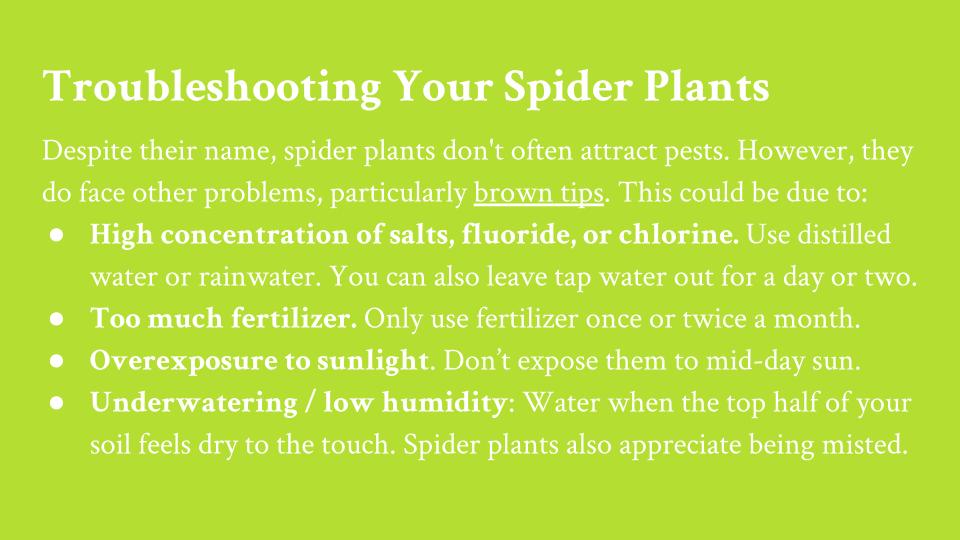Introduction
Don’t ever talk to its son or its son’s son or its son’s son’s son or its son’s son’s son’s son ever again! There’s no other word to describe the spider plant other than prolific. When given adequate water and sunlight, they grow incessantly. Spider plants are those giant tufted mounds of striking leaves that send out little spidery offshoots. They don’t require too much to flower, either — treat them well and revel in their beauty! These easy-care plants are ubiquitous as well, so if you see one at the grocery store, give it a shot!

Characteristics of Spider Plants
You know spider plants when you see them. Often placed in hanging baskets, these plants grow in tufts with arching leaves that are roughly 3/4 inch in width. The leaves, which can be green or variegated, will quickly shoot out more baby spiders (spiderettes) from thin stems. They occasionally produce tiny white flowers. While the leaves are often straight, you may also encounter curly varieties, which are also called Bonnie spider plants.


History of Spider Plants
The spider plant is native to South Africa. It’s also known as the airplane or ribbon plant. Its common name, quite evidently, comes from its spider-like appearance. Scientifically, it’s called chlorophytum comosum, which is quite the mouthful! In Greek, “chloros” means yellow-green, and “phyton” means plant. “Coma” (comosum) refers to tufts of hair.
Varieties of Spider Plants
- Mandaianum: These have 4 to 6-inch short leaves that are dark green with a central yellow stripe.
- Picturatum: These have 12-inch medium green leaves with a yellow stripe.
- Variegatum: These have 15-inch leaves that are edged with white.
- Vittatum: These have 6 to 12-inch long medium green leaves with a wide, cream-colored stripe.


Caring for Spider Plants
Spider plants are relatively low maintenance. They grow fast — seriously, they’ll take over your life! They like to be kept warm in temperatures that are at least 45° F, but they generally thrive best between 55° to 80° F. While they appreciate bright indirect light, don’t expose them to scorching mid-day sun if you leave them outside. They also love water and humidity in moderation. Feed them a standard liquid fertilizer every 2 weeks during the spring and summer, if you’re so inclined.
Propagating Spider Plants
Spider plants are easy to propagate — you can do that in three different ways. In any case, begin by grabbing a plantlet with a node so that it’s easier for roots to grow out.
- Cut off your plantlet and stick it in soil, then wait for the roots to grow.
- Cut off your plantlet and stick it in a vial of water, then wait for the roots to grow.
- Leave your plant on the mother plant, then stick it in little planters with soil. When the roots grow out, snip off the spiderette. This method allows the babies to get nutrients from the mom plant, but it is space-consuming.
Troubleshooting Problems With Your Spider Plants
Despite their name, spider plants don’t often attract pests. However, they do face other problems, particularly brown tips. This issue could be due to a variety of reasons:
- High concentration of salts, fluoride, or chlorine. Give your plant distilled water or rainwater. You can also leave your water out for a day or two before using it.
- Too much fertilizer. Spider plants can benefit from fertilizer, but using it more than once every two weeks during growing season can make for an unhappy plant.
- Overexposure to sunlight. While spider plants appreciate bright indirect light, they can’t withstand direct mid-day light.
- Underwatering / low humidity: While you don’t want to keep them in wet soil, water when the top half of your planter feels dry to the touch. Spider plants also appreciate you misting them a couple times a week.
Sources
- https://hgic.clemson.edu/factsheet/spider-plant/
- http://pza.sanbi.org/chlorophytum-comosum
- https://pss.uvm.edu/ppp/articles/spiderplant.html
- https://gardeningsolutions.ifas.ufl.edu/plants/houseplants/spider-plant.html
- https://www.almanac.com/plant/spider-plants
- Reader’s Digest: Success With House Plants














